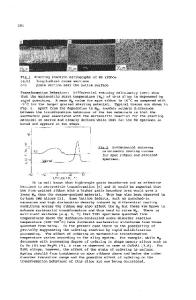Shape Memory Behavior of Ti-Ni Thin Films Annealed at Various Temperatures
- PDF / 326,566 Bytes
- 6 Pages / 414.72 x 648 pts Page_size
- 8 Downloads / 321 Views
INTRODUCTION Micromachines such as manipulators and fluid microvalves are currently expected to be used in various fields such as medicine, biotechnology, micro optics and the semiconductor production. In order to work such a micromachine, an effective small actuator is necessary. Among the microactuators proposed at present, the actuator with shape memory thin films is considered to be an attractive candidate for a microactuator owing to their large deformation and strong recovery force. There have been several papers suggesting the potential of Ti-Ni thin films[1-4]. The Heati As present authors also showed in.........ri previous papers[5,6] that sputter deposited thin films of Ti-Ni exhibit almost perfect shape memory effect Ms+M2 As+Af A - 2 G comparable to that in a bulk Ti-Ni. However, the shape memory E behavior of Ti-Ni thin films is very sensitive to the heat treatment. In the A.. present paper, we investigate the effect of the annealing temperature on cooling the shape memory behavior of Ti-Ni thin films.
7
M=
Temperature (K) EXPERIMENTAL Thin films of Ti-Ni with three different compositions were deposited on glass substrates by r. f. magnetron
Fig. 1 Schematic strain vs. temperature curve obtained upon cooling and heating under a constant stress and definition of the transformation temperatures used in the present paper. 381
Mat. Res. Soc. Symp. Proc. Vol. 360 0 1995 Materials Research Society
sputtering. The sputtering conditions used in this study were as follows: substrate temperature, 523K; Ar gas pressure, 0.3Pa; r. f. power, 600W; substrate-to-target distance, 80mm; deposition time, 7.2ks. In order to obtain a variety of film compositions, several discs of pure titanium with a diameter of 10mm were placed on the 6 in. diameter target of Ti-50at.%Ni alloy. The thickness of the deposited films ranged from 6 to 9 gim. After the sputtering, they were removed from the glass substrates and then heat treated to produce crystallization of Ti-Ni. The heat treatments were carried out for 3.6ks at three different temperatures, 773K, 873K and 973K. Since transmission electron microscopy and X-ray diffractometry revealed that the three kinds of films exhibited a two-phase structure with a dispersion of fine Ti2 Ni precipitates in a TiNi matrix, a TiNi single-phase structure and a two-phase structure with a dispersion of fine Ti3 Ni4 precipitates in a TiNi matrix, respectively, the film compositions were estimated to be Tirich Ti-Ni, near equiatomic TiNi and Ni-rich Ti-Ni. The shape memory behavior of the annealed with an automatically controlled heater. films was measured with a small tensile tester equipped The size of the sample used for this test was lx5mm 2 and the thickness was in the range of 6 to 9[Lm. This test involved loading the sample at a high temperature, cooling it down to1 143K at a rate of -10K min-' and heating it back to the original temperature at a rate of 10K min- . Figure 1 shows a schematic curve representing the typical behavior of the shape change in the films upon cooling and h
Data Loading...











